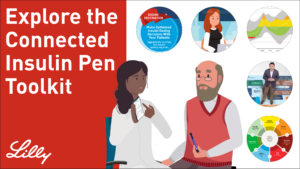Resources to Help Educate People with Diabetes
SPONSORED
 Diabetes is a complex health condition, demanding an in-depth understanding of therapy, including multiple daily injections, for effective management. Education plays a pivotal role in navigating diabetes care, providing individuals with the knowledge necessary to make informed decisions regarding lifestyle, nutrition, medication, and devices. Staying informed about the latest developments in diabetes research and treatment options is crucial for individuals, caregivers, and healthcare professionals (HCPs) to create a collaborative treatment relationship to address the challenges posed by diabetes. Through continuous learning and informed decision-making, individuals can skillfully navigate the complexities of diabetes.
Diabetes is a complex health condition, demanding an in-depth understanding of therapy, including multiple daily injections, for effective management. Education plays a pivotal role in navigating diabetes care, providing individuals with the knowledge necessary to make informed decisions regarding lifestyle, nutrition, medication, and devices. Staying informed about the latest developments in diabetes research and treatment options is crucial for individuals, caregivers, and healthcare professionals (HCPs) to create a collaborative treatment relationship to address the challenges posed by diabetes. Through continuous learning and informed decision-making, individuals can skillfully navigate the complexities of diabetes.
Diabetes care is continuously evolving, and a noteworthy development is the emergence of Connected Insulin Pens, or CIPs. These devices have grown more common among patients with diabetes who are taking insulin injections. They provide automatic capture and transfer of insulin dose related information to compatible smartphone applications and, in some cases, dedicated HCP portals. What distinguishes CIPs is their ability to integrate insulin and glucose data, providing HCPs with real-time insights for more informed and precise dosing information. This integration enhances monitoring efficiency and offers potential for personalized treatment plans tailored to the individual needs of each patient.
New resources from Lilly have been created to help you in the utilization of Connected Insulin Pens. Click here to access various diabetes education resources for you and your patients, including the Connected Insulin Pen Toolkit. In this article, we’ll take a closer look at these resources.
Let’s Go DIGITAL Tip Sheet
One of the benefits of CIPs is that HCPs are often provided with a downloadable report that shows information such as insulin and glucose data together. The amount of information within these reports, while beneficial, can often pose the challenge of not knowing where to start. The “Let’s Go DIGITAL Tip Sheet” is an interactive PDF designed to empower HCPs in standardizing and refining their approach to reviewing CIP reports. This resource, presented under the “Let’s Go DIGITAL” acronym, serves as a structured guide for efficient data interpretation. Complementing this tool is a video demonstration by diabetes technology expert and adult endocrinologist, Dr. David Ahn, MD, which provides a comprehensive visual guide that enhances accessibility and utilization of this resource.
Get Connected: Incorporating CIPs into Clinical Practice
Upon making the decision to integrate CIPs into your medical practice, the next question is often, “Where do I begin?” Considerations may include training your office staff, selecting appropriate candidates, prescribing for patients, and navigating reimbursement. The goal of the “Get Connected: Incorporating CIPs into Clinical Practice” infographic is to help guide you through this journey. This comprehensive resource walks you through essential aspects of incorporating CIPs into your practice. Additionally, for a visual walkthrough, you have the option to watch a demonstration by Dr. Ahn.
The Diverse Use of CIPs
Another resource depicts the journeys of three hypothetical individuals navigating the complexities of diabetes management. In this series of short, animated videos, three distinct patients with various backgrounds who are looking to improve their treatment plans with the assistance of a CIP are presented.
Adam records his glucose digitally but is caught up in his busy lifestyle and does not write down his insulin doses. This presents a common challenge that makes it difficult to appropriately achieve his glycemic targets. Bridget grapples with the balance of managing her diabetes amid her work schedule that involves regular travel. Her struggle with more frequent highs after meals serves as an example of unique challenges faced by individuals with evolving lifestyles. Finally, Charles has a fear of hypoglycemia that has become a significant hurdle in independently adjusting his basal insulin. Throughout these three unique cases, their HCP encounters a recurring obstacle: the absence of comprehensive data. The animated modules about Adam, Bridget, and Charles explore providing tailored care and address the inherent complexities of diabetes management.
Optimizing Insulin Dosing Decisions With a CIP
Follow along on an animated journey with Franklin, who has recently integrated mealtime insulin and adopted a continuous glucose monitor (CGM). Seeking enhanced insulin dosing, Franklin is guided by his physician, Dr. Lee, to explore the use of a CIP. After a three-month follow up, data from both the CGM and CIP provide a clearer picture of Franklin’s glycemic excursions. The collaboration between technology and medical expertise shows the power of personalized care, empowering individuals like Franklin to navigate diabetes with greater insight and with effectively tailored treatment plans.


